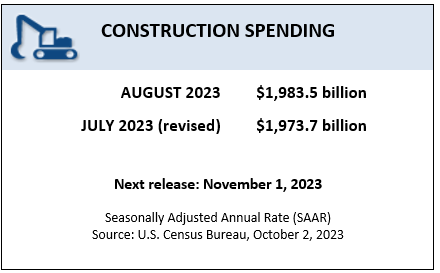According to the U.S. Census Bureau, construction spending during August 2023 was estimated at a seasonally adjusted annual rate of $1,983.5 billion, 0.5% (±1.2%) above the revised July estimate of $1,973.7 billion. The August figure is 7.4% (±1.8%) above the August 2022 estimate of $1,847.3 billion. During the first eight months of this year, construction spending amounted to $1,284.7 billion, 4.2% (±1.2%) above the $1,233.4 billion for the same period in 2022.
In August, the estimated seasonally adjusted annual rate of public construction spending was $431.6 billion, 0.6% (±2.1%) above the revised July estimate of $429.1 billion. Educational construction was at a seasonally adjusted annual rate of $90.6 billion, 0.2% (±3.5%) above the revised July estimate of $90.4 billion. Highway construction was at a seasonally adjusted annual rate of $130.4 billion, 0.4% (±5.1%) above the revised July estimate of $130.0 billion.
Spending on private construction was at a seasonally adjusted annual rate of $1,551.8 billion, 0.5% (±0.7%) above the revised July estimate of $1,544.6 billion. Residential construction was at a seasonally adjusted annual rate of $879.9 billion in August, 0.6% (±1.3%) above the revised July estimate of $874.7 billion. Nonresidential construction was at a seasonally adjusted annual rate of $671.9 billion in August, 0.3% (±0.7%) above the revised July estimate of $669.9 billion.

“For now, all types of construction are growing,” said Ken Simonson, Associated General Contractors of America chief economist. “But unless the supply of qualified workers increases, many projects are likely to be delayed.”
“We are seeing strong and growing investments in construction projects from both the private and the public sectors,” said Stephen E. Sandherr, the association’s chief executive officer. “But without new investments in construction education & training as well as programs to allow skilled construction workers into the country, those projects are going to take longer and cost more to get built.”
“Aggregate nonresidential construction spending expanded at a respectable rate in August,” said Associated Builders and Contractors (ABC) Chief Economist Anirban Basu. “But manufacturing-related and public sector projects accounted for more than 100% of the monthly increase. Privately financed commercial- and educational-related construction spending declined by almost 1% at least partially due to elevated borrowing costs.
“Despite high interest rates and ongoing weakness in certain segments like office and retail, contractors remain relatively upbeat,” said Basu. “Despite still-high materials costs and ongoing labor shortages, a plurality of contractors expect their profit margins to increase over the next six months, according to ABC’s Construction Confidence Index.”

